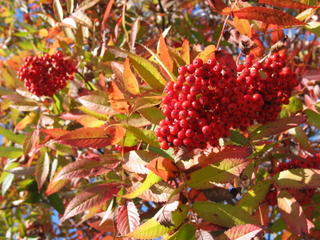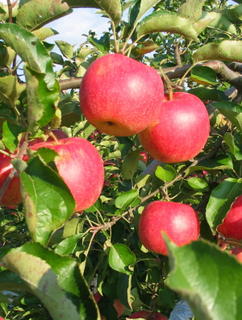Friday, October 14, 2005
A Severe Winter? ・ 厳冬になるか?
In Minnesota, people are always talking about the weather. It is almost as common to say something about the weather as it is to simply say hello. Today's weather is of course always worth commenting on, but people are also always trying to predict the upcoming weather. One major topic at this time of year is the severity of the upcoming winter.
ミネソタでは皆が天気の話をよくします。「ハロー」の代わりに「寒いですね」 など、天気についてのコメントは挨拶になっている程です。「今日の天気」についてコメントするのもいいですが、これからの気候を予想することもよくしま す。そして毎年の今頃になると、これからの冬の厳しさが大きな話題になります。
The metrological agency looks at weather patterns and other historical data, but in my opinion, they really have no idea what the weather will be like three months from now. Before weather forecasts too, people tried to predict seasonal weather trends. They often used folklore based on signals found in the natural world. In reality, these predictions are probably no more or less accurate than the science the weathermen use, but they are interesting to look at.
気象庁では歴史的なデータを使って季節予報を作りますが、僕の意見ですが、その人たちは3ヵ 月後の気候のことがぜんぜん分かりません。推測に過ぎないと思います。季節予報が出される前に、一般の人々が自然の中の色々な要素を観察して、季節予報ら しいものを作りました。それらの要素は世代に渡って教えられてきて、言い伝えになっています。それもよく当たったとは言えませんが、現在の科学に基づいて いる予報に相当するようなものでしょう。それにしても、その言い伝えを見るのはちょっと楽しいです。
 I don't know if American traditional measures will work with Japanese weather, but let's take a look at some of those I regularly heard.
I don't know if American traditional measures will work with Japanese weather, but let's take a look at some of those I regularly heard.
アメリカの気候を予測する言い伝えが日本の天気にも使えるか分かりませんが、僕がよく耳にした言い伝えをちょっと見て、今年の冬を考えてみましょう。
One of the most common predictors I have heard about is the number of mountain ash berries. People say that if there are lots of berries, it will be a long winter. Judging from the trees that I see around here, Inakadate and Aomori is in for a real bad winter.
僕は小さい頃からよく耳にした気候を予想するの一つは、「ナナカマドの実が特別に多ければ、冬が特別に長い」ということです。去年おととしの青森の状況と比較できませんが、今年の田舎館村のナナカマドを見た限り、今年の冬は大変長くなる感じです。
 Another folklore method of predicting a severe winter in the USA is done by looking at the skin of fruits and vegetables. If the skin on an onion or an apple is particularly thick and strong, a terrible winter can be expected. There certainly are lots of apples here in Aomori, what do the skins look like? The ones I have peeled seem a bit tough....
Another folklore method of predicting a severe winter in the USA is done by looking at the skin of fruits and vegetables. If the skin on an onion or an apple is particularly thick and strong, a terrible winter can be expected. There certainly are lots of apples here in Aomori, what do the skins look like? The ones I have peeled seem a bit tough....
もう一つ昔から伝えられた厳しい冬を予言するものは野菜や果物に見ることがで きます。その生産物(特にりんごと玉ねぎ)の皮が例年より厚くて、強いものでしたら、その後に来る冬が寒くなると言われています。ここの青森県にはりんご が多いですが、皮はどんな感じですか?僕がむいたりんごはちょっと固目かな。。。
In Minnesota, people often look at wild animals to forejudge the upcoming winter. If the squirrels are particularly busy collecting nuts or the beavers make a particularly thick or tall dam, people say the winter will be worse. Since we don't have either squirrels or beavers in Aomori, I can't use this as an estimating tool. What about the other animals?
ミネソタでは、人々はその周りにいる野生動物を見て、これからの冬を予測しま す。リスが特別に熱心にどんぐりなどを集めているなら、またはビーバーのダムが特別に高く建てられているならば、その冬はそれ相当に長くなると言われてい ます。この田舎館ではリスもビーバーもいませんので、それは予測するには使い物にはなりません。他の動物はどうでしょうか?
Finally, people say that if you still have lots of flowers blooming until late into the fall, then a severe winter is on the way. I don't know if you can call this the end of autumn, but in Minnesota the first snow has already fallen and it is winter. Looking around Inakadate and the many flowers still to be found here and there, I think we may be in trouble…
最後に、「秋の末まで花がきれいに咲いているならば、冬が特別に寒くなる」と いう言い伝えがあります。ここの田舎館ではまだまだ「秋の末だ」といわないかも知れませんが、僕のミネソタでは、もう既に初雪が降っていて「秋が終わった 感じ」だそうです。この田舎館を見たら、花がまだまだたくさんあるから、これからの冬は怖い物になるかも知れません。。。。
What do you think? Do American measures work in Japan?
どうですか?アメリカの予測法は日本でも通用しますか?
ミネソタでは皆が天気の話をよくします。「ハロー」の代わりに「寒いですね」 など、天気についてのコメントは挨拶になっている程です。「今日の天気」についてコメントするのもいいですが、これからの気候を予想することもよくしま す。そして毎年の今頃になると、これからの冬の厳しさが大きな話題になります。
The metrological agency looks at weather patterns and other historical data, but in my opinion, they really have no idea what the weather will be like three months from now. Before weather forecasts too, people tried to predict seasonal weather trends. They often used folklore based on signals found in the natural world. In reality, these predictions are probably no more or less accurate than the science the weathermen use, but they are interesting to look at.
気象庁では歴史的なデータを使って季節予報を作りますが、僕の意見ですが、その人たちは3ヵ 月後の気候のことがぜんぜん分かりません。推測に過ぎないと思います。季節予報が出される前に、一般の人々が自然の中の色々な要素を観察して、季節予報ら しいものを作りました。それらの要素は世代に渡って教えられてきて、言い伝えになっています。それもよく当たったとは言えませんが、現在の科学に基づいて いる予報に相当するようなものでしょう。それにしても、その言い伝えを見るのはちょっと楽しいです。
 I don't know if American traditional measures will work with Japanese weather, but let's take a look at some of those I regularly heard.
I don't know if American traditional measures will work with Japanese weather, but let's take a look at some of those I regularly heard.アメリカの気候を予測する言い伝えが日本の天気にも使えるか分かりませんが、僕がよく耳にした言い伝えをちょっと見て、今年の冬を考えてみましょう。
One of the most common predictors I have heard about is the number of mountain ash berries. People say that if there are lots of berries, it will be a long winter. Judging from the trees that I see around here, Inakadate and Aomori is in for a real bad winter.
僕は小さい頃からよく耳にした気候を予想するの一つは、「ナナカマドの実が特別に多ければ、冬が特別に長い」ということです。去年おととしの青森の状況と比較できませんが、今年の田舎館村のナナカマドを見た限り、今年の冬は大変長くなる感じです。
 Another folklore method of predicting a severe winter in the USA is done by looking at the skin of fruits and vegetables. If the skin on an onion or an apple is particularly thick and strong, a terrible winter can be expected. There certainly are lots of apples here in Aomori, what do the skins look like? The ones I have peeled seem a bit tough....
Another folklore method of predicting a severe winter in the USA is done by looking at the skin of fruits and vegetables. If the skin on an onion or an apple is particularly thick and strong, a terrible winter can be expected. There certainly are lots of apples here in Aomori, what do the skins look like? The ones I have peeled seem a bit tough....もう一つ昔から伝えられた厳しい冬を予言するものは野菜や果物に見ることがで きます。その生産物(特にりんごと玉ねぎ)の皮が例年より厚くて、強いものでしたら、その後に来る冬が寒くなると言われています。ここの青森県にはりんご が多いですが、皮はどんな感じですか?僕がむいたりんごはちょっと固目かな。。。
In Minnesota, people often look at wild animals to forejudge the upcoming winter. If the squirrels are particularly busy collecting nuts or the beavers make a particularly thick or tall dam, people say the winter will be worse. Since we don't have either squirrels or beavers in Aomori, I can't use this as an estimating tool. What about the other animals?
ミネソタでは、人々はその周りにいる野生動物を見て、これからの冬を予測しま す。リスが特別に熱心にどんぐりなどを集めているなら、またはビーバーのダムが特別に高く建てられているならば、その冬はそれ相当に長くなると言われてい ます。この田舎館ではリスもビーバーもいませんので、それは予測するには使い物にはなりません。他の動物はどうでしょうか?
Finally, people say that if you still have lots of flowers blooming until late into the fall, then a severe winter is on the way. I don't know if you can call this the end of autumn, but in Minnesota the first snow has already fallen and it is winter. Looking around Inakadate and the many flowers still to be found here and there, I think we may be in trouble…
最後に、「秋の末まで花がきれいに咲いているならば、冬が特別に寒くなる」と いう言い伝えがあります。ここの田舎館ではまだまだ「秋の末だ」といわないかも知れませんが、僕のミネソタでは、もう既に初雪が降っていて「秋が終わった 感じ」だそうです。この田舎館を見たら、花がまだまだたくさんあるから、これからの冬は怖い物になるかも知れません。。。。
What do you think? Do American measures work in Japan?
どうですか?アメリカの予測法は日本でも通用しますか?
Free Web Counter